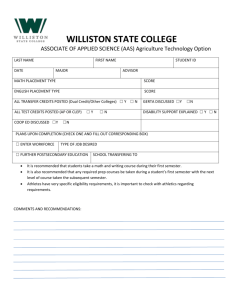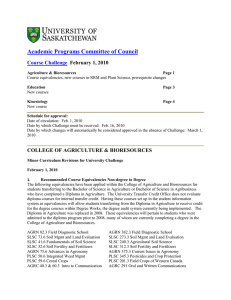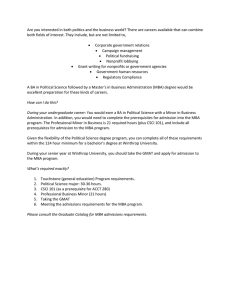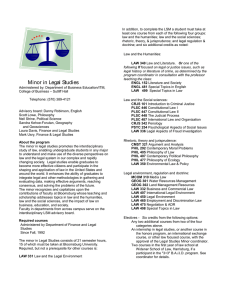Academic Programs Committee of Council Course Challenge February
advertisement
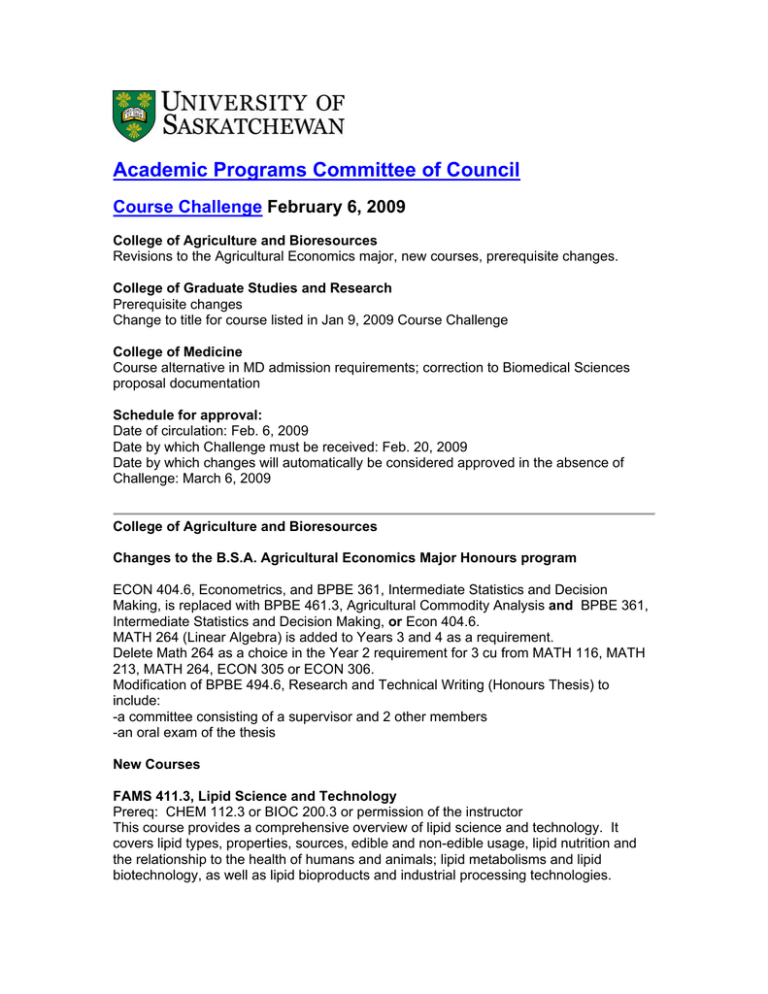
Academic Programs Committee of Council Course Challenge February 6, 2009 College of Agriculture and Bioresources Revisions to the Agricultural Economics major, new courses, prerequisite changes. College of Graduate Studies and Research Prerequisite changes Change to title for course listed in Jan 9, 2009 Course Challenge College of Medicine Course alternative in MD admission requirements; correction to Biomedical Sciences proposal documentation Schedule for approval: Date of circulation: Feb. 6, 2009 Date by which Challenge must be received: Feb. 20, 2009 Date by which changes will automatically be considered approved in the absence of Challenge: March 6, 2009 College of Agriculture and Bioresources Changes to the B.S.A. Agricultural Economics Major Honours program ECON 404.6, Econometrics, and BPBE 361, Intermediate Statistics and Decision Making, is replaced with BPBE 461.3, Agricultural Commodity Analysis and BPBE 361, Intermediate Statistics and Decision Making, or Econ 404.6. MATH 264 (Linear Algebra) is added to Years 3 and 4 as a requirement. Delete Math 264 as a choice in the Year 2 requirement for 3 cu from MATH 116, MATH 213, MATH 264, ECON 305 or ECON 306. Modification of BPBE 494.6, Research and Technical Writing (Honours Thesis) to include: -a committee consisting of a supervisor and 2 other members -an oral exam of the thesis New Courses FAMS 411.3, Lipid Science and Technology Prereq: CHEM 112.3 or BIOC 200.3 or permission of the instructor This course provides a comprehensive overview of lipid science and technology. It covers lipid types, properties, sources, edible and non-edible usage, lipid nutrition and the relationship to the health of humans and animals; lipid metabolisms and lipid biotechnology, as well as lipid bioproducts and industrial processing technologies. Rationale: Biological lipids from plants, animals and microorganisms are important for human food as well as for industrial applications. With the increased recognition of the health benefits of certain types of lipids, demand is growing for healthier lipids with better fatty acid compositions and improved stereo-specific distributions. Meanwhile, as fossil oil reserve is diminishing, researchers are exploring the possibility of using these renewable resources to replace petroleum oil in chemical industries. These two driving forces have made a great contribution in advancing lipid research in recent years. However, the basics of lipid science & technology and the recent advances in this area have not been systematically examined in other courses on campus. As biological lipids are becoming of increasing importance to our daily life and to our regional economy, the University of Saskatchewan needs such a course, which will be of benefit to those students who want to pursue careers in this field or those who simply wish to have a better understanding of Lipid Science & Technology. The students in this course will be equipped with a comprehensive knowledge of biological lipids, including types, function, nutrition, metabolism, biotechnology and industrial processing and utilization. In addition, students will have the opportunity to receive instruction from industry experts and to tour industrial oil refining facilities. RRM 301.9, RRM Field Course Prereq: RRM 215.3 Identification of common plant species found in Saskatchewan and identification of soil horizons and profiles are skills necessary for classification of wetlands and delineation of biophysical map units. RRM 301.9 will provide students with an opportunity to further develop and apply the skills obtained in RRM 215.3 in a field setting. This will be done through an extended mapping project, which is intended to be self directed experiential learning. The field course is important for the development of critical thinking skills as part of a university level of education and essential to a successful translation of these skills to the job market. Rationale: Identification of common plant species found in Saskatchewan and identification of soil horizons and profiles are skills necessary for classification of wetlands and delineation of biophysical map units. RRM 301.9 will provide students with an opportunity to further develop and apply the skills obtained in RRM 215.3 in a field setting. This will be done through an extended mapping project, which is intended to be self directed experiential learning. The field course is important for the development of critical thinking skills as part of a university level of education and essential to a successful translation of these skills to the job market. Pre and Corequisite Changes Course Text from online Course Catalogue AGRC 492 – Term Paper Successful completion of 75 cu and Technical Writing towards the BSA degree before registration AGRC 493 – Team Project Successful completion of 75 in Agricultural Science credit units towards the BSA degree before registration AGRC 494 – Research Registered BSA Honours and Thesis students or special permission from the Head of the Recommended Prerequisite Change Successful completion of 75 cu of university level courses Successful completion of 75 cu of university level courses Successful completion of 75 credit units of university level courses AGRN 375 – Current Issues in Agronomy AGRN 382 – Field Diagnostic School ANSC 313 – Animal Breeding and Genetics ANSC 470 – Applied Animal Biotechnology ANSC 480 – Poultry Feeds and Feeding ANSC 492 – Thesis in Animal Science supervising department. AGRC 111, 113; SLSC 240; PLSC 201 or permission of instructor PLSC 201 and SLSC 240 n/a 3 credit units of Genetics courses and 3 credit units Physiology ANSC 212 and ANSC 315 ANSC 313 and VBMS 324 Three years completed towards a BSA degree Successful completion of 75 credit units of university level courses Successful completion of 30 credit units or permission of the instructor AGRC 113 and ECON 111 or successful completion of 60 credit units at the university level or permission of the instructor BPBE 322 or COMM 203 BPBE 343 – Grain and Livestock Marketing n/a BPBE 344 – Follow the Grain A minimum of 60 credit units of university level courses or permission of the instructor BPBE 420 – Farm and Agricultural Business Operations Management BPBE 430 – Natural Resource Economics AGEC 322 or an equivalent intermediate finance course BPBE 432 – Rural Development Theory Policy and Case Studies BPBE 445 – Competition Regulation and Antitrust Theory and Applications BPBE 461 – Agricultural Commodity Analysis BPBE 495 – Agribusiness Venture Management EVSC 220 – Environmental Soil Science EVSC 420 – Environmental Fate and AGRC 111 and 113; SLSC 240; one of PLSC 201 or PLSC 222 or permission of the instructor PLSC 201 or PLSC 222 and SLSC 240 BIOC 200 and BIOC 211 ANSC 440 AGEC 315 or equivalent and at least one of AGEC 330,ECON 275 or 277 or permission of the instructor ECON 211 and 214 One of BPBE 330, ECON 275 or ECON 277 ECON 211 BPBE315 or permission Corequisite: BPBE 361 BPBE 315 and 361 or permission of the instructor AGEC 361 or equivalent BPBE 315 and 361 Open to third and fourth year students registered in the College of Agriculture and Bioresources and the Edwards School of Business AGRC 111 or 6 credit units of GEOG or GEOL Successful completion of 90 credit units of university level courses or permission of the department 60 credit units in a sciencebased program(e.g. Math 101 or 110; PHYS 115 or EVSC 210; successful AGRC 111 or 3 credit units in GEOG or GEOL Transport of Toxic Substancies EVSC 485 – Environmental Science Capstone course EVSC 492 – Research and Term Paper FAMS 492 – Literature Thesis PLSC 340 – Weed Biology and Ecology PLSC 345 – Pesticides and Crop Protection PLSC 401 – Sustainable Crop Production B.Sc.,B.S.A.,B.E.) including Math 101 or 110 and Phys 111 or EVSC 210, or permission of the instructor Fourth year BSA Environmental Science major Successful completion of 75 credit units towards the Environmental Science BSA degree Successful completion of 75 credit units towards the BSA in the FAMS major AGRC 111,AGRC 112,or at least one 200-level botany course (e.g., BIOL 222, 202 or 205) BIOL 120 and 121, PLSC 335,CHEM 250 or permission of the instructor AGEC 320 or permission of the instructor PLSC 492 – Literature Thesis in Plant Sciences Completion of 81 credit units toward the BSA Plant Sciences major SLSC 492 – Research and Successful completion of 75 Term Paper credit units towards the BSA Soil Science degree completion of 60 credit units of university level courses Successful completion of 75 credit units of university level courses Successful completion of 75 credit units of university level courses Successful completion of 75 credit units of university level courses AGRC 111 or one of BIOL 202, 222 or 205 BIOL 120 and PLSC 335 PLSC 335, SLSC 312 and successful completion of 75 credit units of university course work. Successful completion of 81 credit units of university level courses. Successful completion of 75 credit units of university level courses. College of Graduate Studies and Research Change to prerequisite TOX 860.3 Applied toxicology Original prerequisite: VBMS 836 and 837 and permission of the instructor. Recommend additional credit units in TOX Revised prerequisite: Registration in the Toxicology Graduate Program or permission of the instructor. Approved Joint Master’s and Ph.D. Committee Dec 9, 2008. Revision to Jan. 9, 2009 Course Challenge: Title change for PUBP 814.3 “Social Policy” to “Social Policy: Interdisciplinary Perspectives” College of Medicine Modification to University of Saskatchewan prerequisites for application to the College of Medicine BMSC/BIOL 224.3 (Animal Body Systems) will be considered equivalent to BIOL 121.3 (Diversity of Life) as a College of Medicine prerequisite course. Rationale: For biology prerequisites taken at the U. of S., students will normally do BIOL 120.3 and 121.3. The new core Biomedical Sciences Program will result in some students being unable to take the BIOL121.3 course in their first two years of university. Because of this, we are proposing that students attending the U. of S. be allowed to use the new three-credit course BMSC/BIOL 224.3 (Animal Body Systems) as equal to BIOL 121.3 when medicine prerequisites are being considered. Correction Page 4 of the Biomedical Sciences revision proposal approved by Council in June, 2008 should be corrected to show that BIOC 230.3 is NOT being discontinued.
